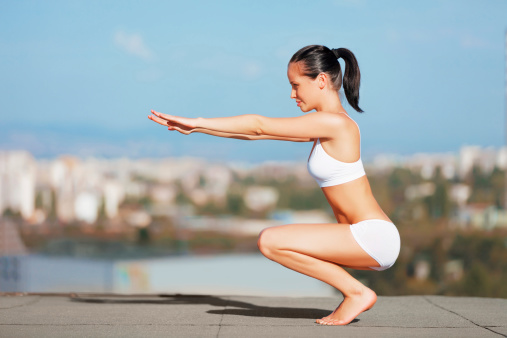You may think the title is a ridiculous statement. How can you work out 24/7? That can’t be healthy. While that is absolutely true, you can use what you have learned in your Pilates workout in everyday tasks to encourage even more muscle memory and faster progress.
Walking
When we learn how to walk, we just do it. No one every really thinks about the mechanics of walking. Walking is a fairly involved process and when we form bad muscular habits, over time our walk, or gait, is affected. This may cause back, shoulder, knee and foot issues that can be painful and costly do deal with. So often, when we walk, we don’t really walk — we shuffle. Pick up your feet! Your feet should strike the ground in a very specific way. The heel strikes the floor first and then the toes follow starting with the pinkie toe, then the others in succession. The toes should leave the floor in the same way. Your pelvis should be in a neutral position and the ribcage and shoulders and head should be over the pelvis. The shoulders should be back and chest should be open. Most of us tend to go to one extreme or the other. Slumping and jutting the chin forward or over arching the lower back and putting too much weight on the toes. Practicing your gait can do amazing things for biomechanical imbalances.
Driving
Driving and sitting are similar tasks though I find positioning my body while driving to be much more of a challenge. Most car seats aren’t designed to promote proper posture; they are designed for esthetics and ‘comfort’. Most people recline their seats back way too far. It’s best to sit as upright as possible and imagining your tailbone reaching through the seat to the floor. The muscles that surround the shoulder blades should be engaged to keep them down and the grip on the steering wheel should be safe, but light. Check at the next stoplight or in traffic to see if you have an iron grip on the steering wheel. If you do, you might be causing neck tension.
Gardening
Though it is fairly obvious that kneeling for long periods of time isn’t good for the body, neither is bending over or squatting. Mix it up. If you can split up your gardening session that would be my suggestion, or if that’s not possible, vary the way you are positioning your body. If you have to kneel, place a pad under the knees so that the patella (knee cap) is not on the ground. If you have to squat, make sure that your core is engaged and your knees track (or line up) with your second toe. If you have to reach, keep your core in and reach while keeping the shoulder blade and lat muscles drawing down. Bending over at the waist is the least preferable option, but if you must do it, make sure you have even weight between the balls of the feet and the heels and that your knees aren’t locked. Get up slowly by pulling in your abs and rounding up through the spine and lower the same way. People may wonder what on earth you are doing, but it’s much healthier for the back this way.
Lifting
What they say about lifting is true. You need to bend your knees, yes, but you should make sure those knees are aligned properly, the shoulders are drawing down and the abs are pulled in. Breathing is important when you are lifting so you don’t create too much strain in the body. Get into the habit of exhaling on the lift. This will help to engage your lower ab muscles, which help protect the back.
In Pilates, the focus is postural/joint alignment, core strength, and stability of the pelvis, torso and shoulders. Everything you need to do all of the above everyday tasks is taught through the Pilates method, so even when you are off the Reformer or off the mat you can practice all day, everyday to be a stronger you!
Jessica Kuiken is a Los Angeles based Pilates Instructor and Personal Trainer. You can follow her on Twitter for the latest on fitness and healthy living.











-300x200.jpeg)







Great tips! Thanks Jessica! I especially love the one for driving since I find myself gripping that steering wheel all the time!